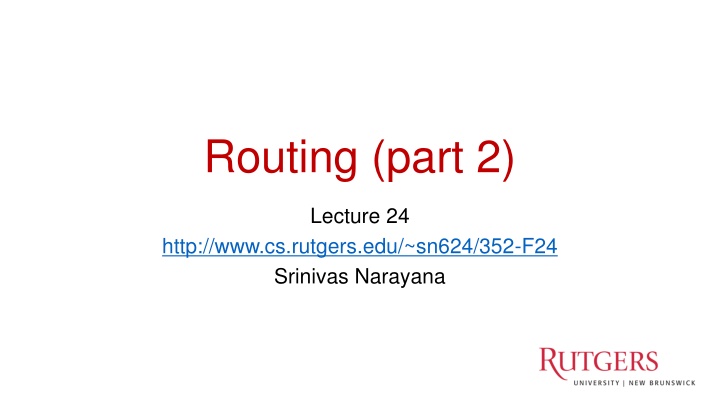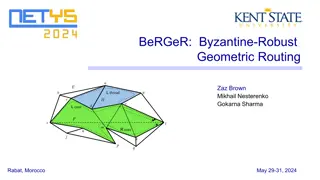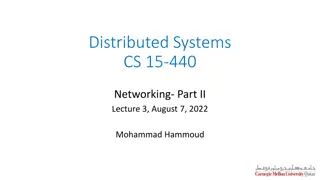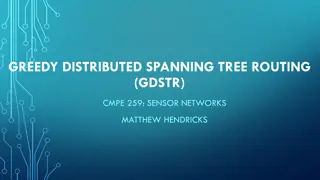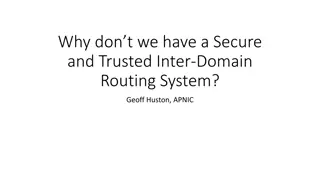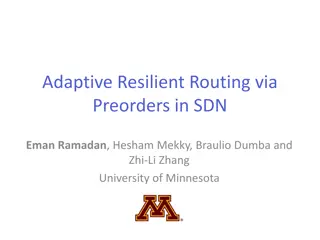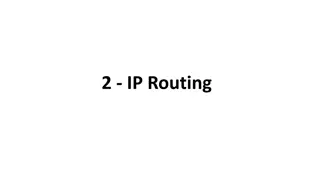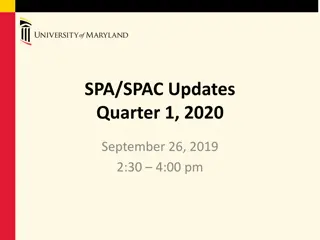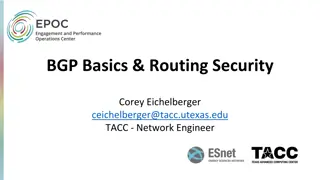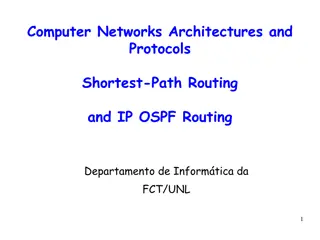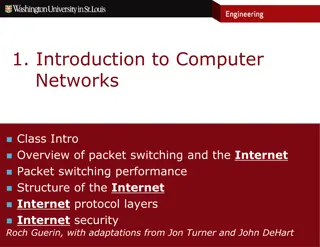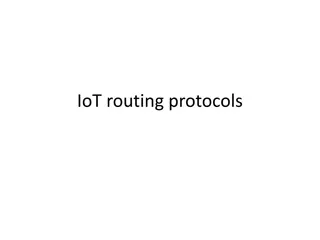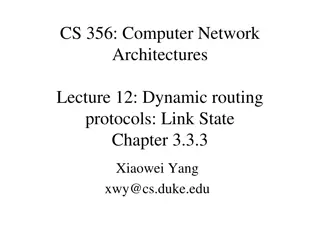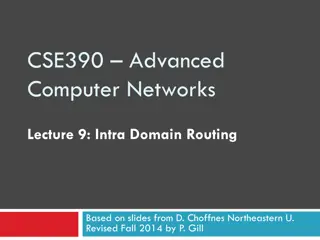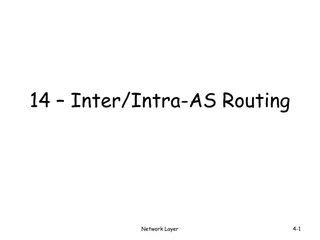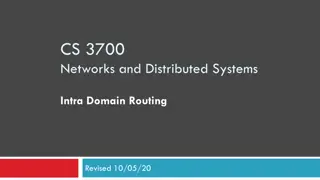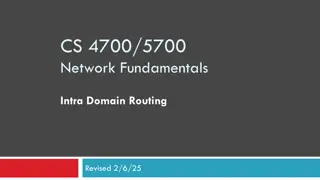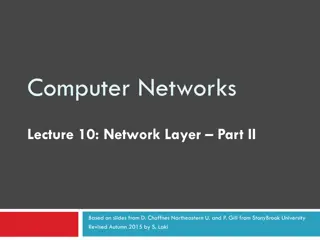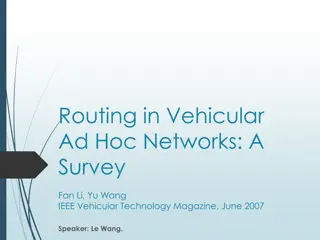Routing Protocols for Internet Networks
This content delves into the intricacies of routing protocols for internet networks, exploring the concepts of distance vector protocols, Bellman-Ford algorithm, and the exchange of distance vectors between routers. It discusses the goals of routing, the computation involved, and the visualization of network paths. By examining the exchange of information and computation methods, a clearer understanding of how routers navigate through networks is presented.
Download Presentation

Please find below an Image/Link to download the presentation.
The content on the website is provided AS IS for your information and personal use only. It may not be sold, licensed, or shared on other websites without obtaining consent from the author.If you encounter any issues during the download, it is possible that the publisher has removed the file from their server.
You are allowed to download the files provided on this website for personal or commercial use, subject to the condition that they are used lawfully. All files are the property of their respective owners.
The content on the website is provided AS IS for your information and personal use only. It may not be sold, licensed, or shared on other websites without obtaining consent from the author.
E N D
Presentation Transcript
Routing (part 2) Lecture 24 http://www.cs.rutgers.edu/~sn624/352-F24 Srinivas Narayana 1
Goals of routing: #1 Good paths #2 Failure resilience Routing: Google Maps for the Internet? Routing protocols Flooding Dijkstra s algorithm 5 Relaxation Link state protocols Distance vector protocols w 3 v w 5 2 u v z Q1. What info exchanged? 2 1 3 1 2 x y 1 Q2. What computation? u
Distance Vector Protocol Each router only exchanges a distance vector with its neighbors Distance: how far the destination is Vector: a value for each destination DVs are only exchanged between neighbors; not flooded Use incomplete view of graph derived from neighbors distance vectors to compute the shortest paths Routing protocols Q1. What info exchanged? Link state protocols Distance vector protocols Q2. What computation?
Q1: Distance Vectors Dx(y) = estimate of least cost from x to y Distance vector: Dx = [Dx(y): y N ] Node x knows cost of edge to each neighbor v: c(x,v) Node x maintains Dx Node x also maintains its neighbors distance vectors For each neighbor v, x maintains Dv = [Dv(y): y N ] Nodes exchange distance vector periodically and whenever the local distance vector changes (e.g., link failure, cost changes) 5
Q2: Algorithm Bellman-Ford algorithm Each node initializes its own distance vector (DV) to edge costs Each node sends its DVs to its neighbors When a node x receives new DV from a neighbor v, it updates its own DV using the Bellman-Ford equation: Given dx(y) := estimated cost of the least-cost path from x to y Update dx(y) = minv {c(x,v) + dv(y) } cost of path from neighbor v to destination y minimum taken over all neighbors v of x cost to reach neighbor v directly from x
Visualization Neighbor v sends its distance vector to x. Which neighbor v offers the current best path from x to y? Path through neighbor v has cost c(x,v) + dv(y) Choose min-cost neighbor Remember min-cost neighbor as the one used to reach node y This neighbor determines the output port! v v x dv(y) v y v Use v and link (x,v ) to reach y.
Dx(z) = min{c(x,y) + Dy(z), c(x,z) + Dz(z)} = min{2+1 , 7+0} = 3 Dx(y) = min{c(x,y) + Dy(y), c(x,z) + Dz(y)} = min{2+0 , 7+1} = 2 node x table cost to cost to cost to x y z x y z x y z x y z 0 2 7 x y z 0 2 3 x y z 0 2 3 from from from 2 0 1 7 1 0 2 0 1 3 1 0 node y table cost to cost to cost to x y z x y z x y z y 2 1 x y z x y z 0 2 7 2 0 1 7 1 0 x y z 0 2 3 2 0 1 3 1 0 z from x from from 2 0 1 7 node z table cost to cost to cost to x y z x y z x y z x y z 0 2 7 2 0 1 x y z 0 2 3 x y z from from from 2 0 1 7 1 0 3 1 0 3 1 0 time
Good news travels fast Suppose the link cost reduces or a new better path becomes available in a network. The immediate neighbors of the change detect the better path immediately Since their DV changed, these nodes notify their neighbors immediately. And those neighbors notify still more neighbors until the entire network knows to use the better path Good news travels fast through the network This is despite messages only being exchanged among neighbors 1 y 4 1 x z 2
Bad news travels slowly If router goes down, could be a while before network realizes it. B still thinks it can reach A through C bad! A B C D E 1 2 3 4 Initially C thinks it can reach A through B worse! 3 2 3 4 After 1 exchange 3 4 3 4 After 2 exchanges B, D think they can reach A through C ugly! 5 4 5 4 After 3 exchanges Count to infinity problem 5 6 5 6 After 4 exchanges 7 6 7 6 After 5 exchanges etc to infinity
Bad news travels slowly Reacting appropriately to bad news requires information that only other routers have. DV does not exchange sufficient info. A B C D E B needs to know that C has no other path to A other than via B. DV does not exchange paths; just distances! Poisoned reverse: if X gets its route to Y via Z, then X will announce dX(Y) = in its message to Z Effect: Z won t use X to route to Y However, this won t solve the problem in general (think why.)
Summary: Comparison of LS and DV Link State Algorithms Nodes have full visibility into the network s graph Copious message exchange: each LSA is flooded over the whole network Robust to network changes and failures OSPF Open Shortest Path First (v2 RFC 2328) Distance Vector Algorithms Only distances and neighbors are visible Sparse message exchange: DVs are exchanged among neighbors only Brittle to router failures. Incorrect info may propagate all over net EIGRP Enhanced Interior Gateway Routing Protocol (RFC 7868)
Routing protocols Link state protocols Distance vector protocols Every router is aware of the existence of every other router. Messages reveal information on the full network (graph) structure. Message exchange and forwarding tables scale with network size. These assumptions/settings cannot work on the Internet.
The Internet is a large federated network AT&T Comcast Verizon
The Internet is a large federated network Several autonomously run organizations: No one boss Organizations cooperate, but also compete AT&T Comcast e.g., AT&T has little commercial interest in revealing its internal network structure to Verizon. Verizon
The Internet is a large federated network Several autonomously run organizations: No one boss Organizations cooperate, but also compete AT&T Message exchanges must not reveal internal network details. Comcast Verizon Algorithm must work with incomplete information about its neighbors internal topology.
The Internet is a large federated network Internet today: > 70,000 unique autonomous networks Internet routers: > 800,000 forwarding table entries AT&T Keep messages & tables as small as possible. Don t flood Comcast Verizon Algorithm must be incremental: don t recompute the whole table on every message exchanged.
